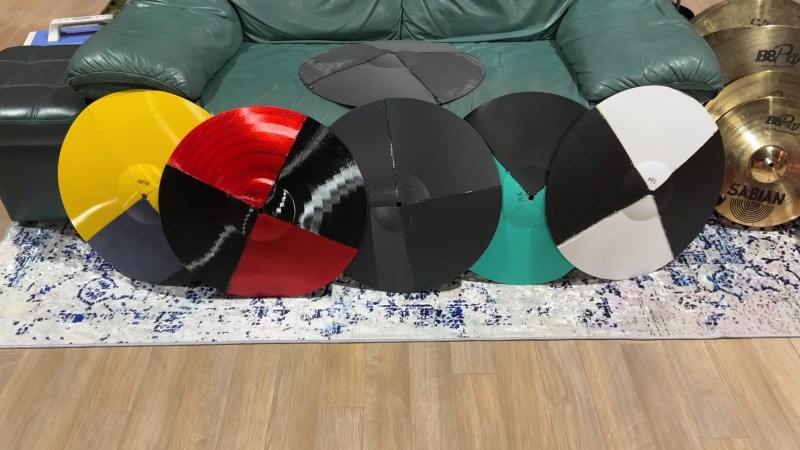We’re big believers in 3D printing here at Hackaday, but it’s important to recognize that there are plenty of applications where additive manufacturing (at least, from a desktop machine) just isn’t suitable. But that doesn’t mean we don’t want to see what happens if you try. For example, [The Drum Thing] wanted to test the limits of 3D printing by printing a set of cymbals.
[The Drum Thing] had a friend design a cymbal in CAD and then the printed quarters were glued together. In the name of science, they produced them in six different materials to compare performance. Each cymbal was played for a short period or until it failed, including some very interesting slow motion camera work showing the vibrations traveling through the cymbals.
As one might expect, bashing “wafer thin” pieces of printed plastic with a wooden drumstick didn’t work out well for most of the cymbals, although the TPU, carbon fiber, and nylon cymbals were did largely survive their time in the limelight. The other cymbals all failed, either shattering, cracking, or failing at the glue joints. Based on the video, it seems the same glue was used for all of the cymbals, so making sure to have a better match between material and adhesive could help with the glue failures.
Maybe future testing can involve playing these cymbals with a quadrotor?
















Could these be improved by electroplating them?
Theoretically yes, but a single layer of electroplating wouldn’t provide much improvement. The real trick would be to do multiple plating passes and build up the metal deposited on the 3D printed core.
The character of the sound of symbals comes from the internal stress caused by hammering in patterns of dents. Electroplating does not introduce stress at all
I’ll give him a pass. Even metal cymbals crack eventually. The question is how long will they last. Commercial plastic (electronic) cymbals don’t last long at all either.
I play plastic water jugs both the fridge tapper size and 5 gallon size. They have more than one second times for the sound to decay. If molded in the right shape and made larger such hard plastic might have some distinctive sound. This applies to the harder plastic which is being phased out it seems. BPA reasons? New water jugs don’t sound as long just a dull thunk.
Um, why glue them rather than print one-piece cymbals?
available print bed size?
I think it was mentioned in the video or the comments that a full cymbal was too big to fit the print bed.
I suspect they could have obtained reasonable results with smaller cymbals. Or asked around for access to a larger printer.
Gluing four wedges together just seems like adding four places for the already weak vibrations to be muted. It would be interesting to put sand or powder on one of the cymbals, and apply vibration at one point on an edge, to visualize the behavior of the waves in the material and interacting at the seams.
it would probably be a lot stronger if he hadn’t just glued along straight edges, but made them interlock like puzzle pieces instead.
Also, the way they break suggests they were printed upright, which is a rather dumb thing to do as the layers are parallel in the direction they are loaded, it would be much stronger if the layers were perpendicular.
Print bed wasn’t large enough.
You could print them in tpu and find a decent adhesive, mount a piezo on them and use them in an electronic set. I’ve been tempted to print some shells for small drums and see how long they last. I’ve printed mounts and brackets for drums and they take a pounding depending on what you print them with and in what orientation. If the mount lasts me a year it’s pretty much paid for itself so long as it doesn’t fail during a gig. I had one pla print fail after a maybe 20 hours of use and it still clung on for the last 3 songs (although it was like a child’s tooth hanging on by a thread at the end).
People often use 3d printers to make things that are simply not a good application of 3d printing. This is perhaps the most silly application for a 3d printer I’ve yet seen.
Might be useful if musical jangly things were hung from the plastic dish. Like a plastic tambourine frame.
Yeah, he knew going in that they were going to explode. He did it because it was fun.
Okay, that was silly, but, that TPU one was rad.
If you had the type of 3D printer where it’s a spindle instead of a bed, you could probably print one as a single spiral so you wouldn’t need glue.
This sounds nothing like a cymbal. I don’t get it at all. It sounds like someone banging on a hunk of plastic so if that is the sound you’re going for (why!?) then just cut a piece of plexiglass from Home Depot and be done with it.
What am I missing here?
The joke is that he’s undergoing methodical testing of something we all assume will sound bad. It could actually lead to something interesting, like a cymbal dampener that fits over the bell, or maybe he’ll try printing a small cymbal in one piece, or he’ll find an improved adhesive. Exploratory science!
You’re missing the laughter
too true
Why not print brass cymbals with uhhh brass? then lathe them to spec if they can’t be printed to spec.
Not everyone needs or has a machine with a $2.5k price tag.